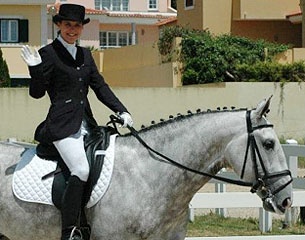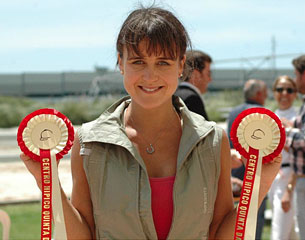
If you ask an Olympic rower they will tell you that the time they spend on the water is only a tiny part of the journey to cross the line first! They spend countless hours on everything from psychological coaching to building team camaraderie. Lucky for them as their teammates can talk. Dressage training is no different and the time you spend off the horse is equally as important as the time you spend on him.
There are many things a rider must work on, including ground work, to take a horse to the top. Things like balance, core stability, horse/rider relationship, mental strength, training reflection and other means of support all help to improve the time when we are actually in the saddle.
Personal Fitness
First is balance. While a rider may be balanced on a horse, this comes and is strengthened by correct balance on the ground and any rider will only benefit from improving their core strength and overall stability on foot. Strength is also key and while one may think that riding horses gives you strength, work in the gym is actually a major part of a top rider's training schedule.
As horseriding itself will only work certain muscle groups, off the horse fitness training will also help lesson the strain on these muscles, strengthening the surrounding muscle groups that can then act to reinforce the effectiveness of the others. For example, if a rider is well balanced in the seat, then a horse can spook and the rider's weight will stay centered, thus not causing more tension and exaggerating the shy further. But if a rider also has a super strong core strength he will be able to withstand a lot more instability from the horse and remain not only balanced but strong in the saddle, helping to guide the horse back into submission without the use of force.
“The best way to improve your core is by the use of functional training , where you have your whole body working at the same time with a specific exercise or movement,” says personal trainer Nuno Fidalgo. “Multi-joint moves/exercises are the best, this means you are using several parts of your body to develop a given movement or exercise, having the main muscle groups working as well as the stabilizing moves. This greatly improves your muscle stability and endurance , as well as the "core" muscles. Recent studies show that using your body as a whole, with a moderate to high Range of Motion (this depends on the athlete’s limitations or past injuries) has greater results than isolating certain muscles.”
However, it is not just about strengthening the muscles we use on the horse, a top rider must also must strive for complete body health and fitness.
“In general terms the body works as a whole so there is no such thing as "muscles you do not use while riding," so you should never isolate the muscles in your everyday activity (either sports or day to day life). In riding this is a major issue, because you are not just sitting, but your whole body is at work to stabilize itself and has to endure the strength of your fellow companion, the horse. You are sitting on top of a 400Kg or more animal of raw power, so the stress is felt all over your body. Of course there are some muscle groups that have a more predominant role than others, but you should,as often as you can, use functional yraining as the main course of action.”
Why do horse riders or athletes, need to be physically strong and fit?
“Like any other activity having specific training helps you plan your sessions, preventing over-fatiguing your body, or under training it! It also gives you the insurance that you will be doing sports/activities specific to your training, rather than wasting you energy and putting stress on your body for training that contributes 0% to your specific goals.”
Fitness is something riders often forget. Just because the horse is doing the ground work, doesn't mean the rider doesn't need to physically exert themselves. Being unfit is certainly a detriment to any horse/rider combination. Just as an unfit horse will lack activity, an unfit rider will actually create an unfit horse.
If we are tired and lack proper muscle tone our aids become less effective, so we use them with no response, and so we use them again, and again, and we become like mini mighty mouses aboard our horses, tickling him constantly, as we work our butts off in the saddle. The more we work, the less responsive he becomes and the less powerful our aids become, so the more we have to use them....dizzy yet?
In order to use light aids we need not only to be strong, but also be fit enough to not tire ourselves during training. In addition a tired rider physically will also tire mentally and then lose the concentration required to train with purpose!
Ground Relationship
Next is the ground relationship, as the marriage between horse and rider begins before the rider is in the saddle. It is important that you establish a rapport with your horse, so he knows you and so you can prepare him and yourself for the training.
 From my experience as a rider I know my horse before I even steps foot in the stable. I know what the ride will be like that day! If Batialo is lying down when I come to prepare him, it means he is relaxed yes, but from experience I know that it also means he is well rested, meaning that it will be a slow warmup before I can get him to properly relax and stretch.
From my experience as a rider I know my horse before I even steps foot in the stable. I know what the ride will be like that day! If Batialo is lying down when I come to prepare him, it means he is relaxed yes, but from experience I know that it also means he is well rested, meaning that it will be a slow warmup before I can get him to properly relax and stretch.
This will be “a small circle with lots of bend” day, to keep control of his hind quarters so we don't fly around out of control! I can also tell just from the way Batialo is holding his ears in the box whether or not, during the lesson to follow, he will be concentrated on the work.
Additionally the mental aspect of dressage riding is crucial: not only the ability to remain calm in a test, but the ability to think about 100 different things at once and not lose it all when it doesn't go right. Time spent preparing and reflecting on training is therefore very important to the overall mental strength of the rider.
I used to think that training was just on the horse, but I have realized, living on the other side of the world from my first and foremost trainer -- my mum -- that training off the horse can teach you so much. As she couldn't see me in person, I had to describe the lessons in detail afterwards and then when I was on the horse, I was more engaged in what I was doing because I knew I needed to recall it for mum later.
I couldn't believe how much more focussed my training became, as I rode with more purpose and direction, having reflected and gone over it in detail the night before.
If you don't have someone to reflect with, write a training journal about the lessons, describe what you did, what worked, what went wrong, and gradually patterns will appear that will help you to understand more why things work the way they do! Often riders get off the horse and don’t think about it until they get back on the next day and by that stage they have forgotten what they needed to work on!
Support is of course crucial to any athlete, but because a rider can't actually discuss the training with the horse in great detail, having someone to vent to is important. When you might be feeling frustrated or inadequate after a training session, having someone to say 'stick at it,' even though you were going to anyway, soothes those down times and helps by allowing you to share the good times as well. Sometimes just having a person there to say 'I had real trouble today' not only helps a lot but can also be part of the reflection process.
The ground work for competition is also vital for success. Riding the test in your head is more important than on the horse, as you can mentally set up each movement. Prepare properly in your head how you will ride before you get the chance to mess it all up in the saddle. it's all the little things that are so often overlooked that actually can cause the most stress.
You do not need to worry about the competition clothes, just need to make sure they are clean and ready..right? Wrong ! Take a test day to put on the competition outfit and give it a spin. Make sure the jodhpurs don't ride up your bum or that your flash black hard hat doesn't give you a migraine! These are all things that we forget, but that once we enter the ring we can't change!
It's the ground work that sets us up for success and while we may think our time in the saddle is important, it is just one aspect to the vast and complex world of competitive dressage!
by Sarah Warne
Related Links
Part I: Classical Training Defined by a Multi-national Team of Young Riders
Part II: Adapting the Training Once You Start Competing
Part III: Progression, Perfection, and Peace
Part IV: A Rider's Ultimate Test, Retraining a Horse
Part V: Progression to Competition, Putting Theory into Practice